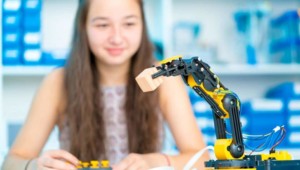Using SAMR to Teach Above the Line
For as long as I can remember I have been an advocate for helping teachers understand the stages of technology integration to help them effectively use tech as a tool for learning.
I’ve adopted a few different tech integration models over the years, discussed the ideas with administrators for use as a starting point for tech integration, and kept the ideas front of mind as I invent and discover new ways for using technology as a tool for learning.
Discussing the stages of tech integration has led to some thought provoking and inspiring conversations, but the ideas have not gained a lot of momentum in my face-to-face teaching environment until now. As many districts jump on board with 1:1 implementation, Apple’s use of the SAMR model as a framework for tech integration presents a consistent, clear and powerful message that is spreading!
About SAMR
Researchers have determined that technology integration typically moves through specific levels. The higher the level of an activity the greater the educational benefit. SAMR is a model of tech integration designed by Dr. Ruben R. Puentedura, Ph.D. that is simple, easy to gauge, and offers all educators something to strive for.
The SAMR model is a useful tool for helping teachers think about their own tech use as they begin to make small shifts in the design and implementation of technology driven learning experiences to achieve the next level. Dr. Puentedura has included Questions and Transitions Ladders with the SAMR model to help teachers make transitions to each level. Teachers in the substitution and augmentation phase can use technology to accomplish traditional tasks, but the real learning gains result from engaging students in learning experiences that could not be accomplished without technology. At the Modification and Redefinition level, the task changes and extends the walls of the classroom.
An Emphasis on Task Design
The key to successful technology integration is the efficient use of digital tools tools that are appropriate for the task. Technology provides us all with the ability to develop our own toolkit of flexible resources for use when needed. Here is an example of a toolkit I assembled to facilitate student driven learning experiences that focus on research, writing and the Common Core. Starting with a good toolkit is essential for designing learning experiences that reach the Modification and Transformation level of the SAMAR model.
A SAMR Example Presented Visually – Walking a Wiki Up the Line
Here is a visual representation of a learning project at each stage of SAMR. It was modeled after a flexible wiki project discovered a long time ago on the blog of Chris Betcher, Betchaboy. The original wiki project was named 25 Australian Moods. I shared the project with a tremendous educator I know named Ashley Kannan and he designed 108 Names of the Constitution.
Now I have walked 108 Names of the Constitution up and down the SAMR Ladder and included Dr. Puentedura’ Questions and Transitions for guidance. If we had been using the SAMR model in 2010, we would have identified Mr. Kannan’s point of entry to be at the Modification level because of his use of commenting through an online discussion. Wikispaces worked really well as a flexible tool for this project at every level of SAMR!
108 Names of the Constitution
Substitution
The SAMR Ladder: Questions and Transitions
What will I gain by replacing the older technology with the new technology?
Augmentation
The SAMR Ladder: Questions and Transitions
Substitution to Augmentation
- Have I added an improvement to the task process that could not be accomplished with the older technology at a fundamental level?
- How does this feature contribute to my design?
Modification
The SAMR Ladder: Questions and Transitions
Augmentation to Modification
- How is the original task being modified?
- Does this modification fundamentally depend upon the new technology?
- How does this modification contribute to my design?
Redefinition
The SAMR Ladder: Questions and Transitions
Modification to Redefinition
- What is the new task?
- Will any portion of the original task be retained?
- How is the new task uniquely made possible by the new technology?
- How does it contribute to my design?
Teaching Above the Line
I am very happy about Apple’s consistent use of the SAMR model as a framework for technology implementation because the clear and consistent message serves as a reminder to teachers about the expectation for each of us to achieve what we cannot achieve without new technology. Last spring I met Shannon Soger, 1-1 coordinator and instructional coach from D100 in Chicagoland. Shannon shared her brilliant PD strategy of challenging the Fab 40 teachers in her 1:1 school to Teach above the line. It’s simple, easy to gauge and something to strive for. Thanks to Shannon for leading the way!
Final Thoughts
As I strive to design projects at the Redefinition level I realize that this level has no boundaries. The SAMR model truly covers the entire spectrum of tech integration. Every lesson, activity and designer has an entry point and those at the highest levels can be continually challenged to redefine learning.







0 Comments
Leave a Comment
Your email address will not be published. All fields are required.